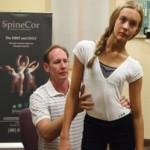
When chiropractor Dr. Andy Pivonka recognized that his young daughter was developing scoliosis, he set out on a mission to identify the most effective treatment options available. His findings not only dramatically helped his daughter, but also led him on a journey that positioned him as a trusted authority in treating patients afflicted with the debilitating condition.
According to mayoclinic.com, scoliosis occurs most often in girls during the growth spurt just before puberty. Its cause is unknown. Most cases are mild, but some children develop spinal deformities that get worse as they grow. Most traditional scoliosis treatments involve mostly either “watch and wait” or hard bracing treatment. A watch and wait approach has no positive effects for the scoliosis patient. Dr. Pivonka asserts, “We’re talking about a deformity in the spine. So we can either sit there and watch the deformity get worse or we can try to prevent the deformity from progressing. Prevention and correction is the approach we take.”
Bracing treatment for scoliosis can be accomplished using either hard braces or the newer soft bracing technology. “Common hard bracing treatment options are mainly used to stabilize a patient but do not typically cause correction to the spine”, said Dr. Pivonka. He added that hard scoliosis bracing options are based on an antiquated ideology. “Many hard bracing options can cause muscular weakness. Once the brace is removed, the weakened muscles then lead to tremendous spinal regression back towards where the patient was before.
For hard bracing treatment, Dr. Pivonka uses the ScoliBrace which relies on causing an over-correction; putting reverse stresses in the spine that can cause a larger amount of change compared to other hard braces.” When opting for hard brace treatment, he identified that the ScoliBrace is far more effective in treating patients, and that the regression of patients when the hard brace is removed is significantly less than with any other hard scoliosis brace.
A newer, even more exciting treatment option that Dr. Pivonka discovered during his quest for solutions, is a soft brace treatment using the SpineCor brace. Primarily, the SpineCor brace is an adjustable, non-invasive technique that provides flexible, inconspicuous correction that continues as a child moves and grows. Dr. Pivonka stated, “In cases where the curve of the spine is less than 40 degrees, the SpineCor brace allows patients to enjoy a complete range of motion without restriction. It also eliminates muscle atrophy while increasing tone in a corrected posture. The soft SpineCor brace can even help to eliminate pain and stop scoliosis before it gets worse.”
According to a recent study by the NIH (National Institute of Health), published in the New England Journal of Medicine, bracing in adolescents with idiopathic scoliosis reduces the likelihood that the condition will progress to the point of requiring surgery. In many cases, the soft SpineCor brace claims to have eliminated the need for surgery, with users experiencing an 89% success rate.
Clearly bracing is worthy of consideration as a preventative and corrective scoliosis treatment option. Besides being more comfortable, the soft SpineCor brace is nearly undetectable when worn under clothing and is the only scoliosis brace that preserves normal body movement and growth and allows normal activities of daily living. In fact, patients with the SpineCor brace are encouraged to be physically active while wearing it.
“For my daughter’s scoliosis treatment, we chose the SpineCor soft brace. She is very athletic and involved in several sports and physical activities, so we looked for an option that would not restrict her motion. The results were nothing short of amazing. So amazing in fact, that I became certified in SpineCor corrective bracing and am currently one of very few providers in Arizona to offer this exciting treatment option”.
For patients suitable for SpineCor treatment, the brace is custom fitted and the patient is taught how to use it effectively. Generally, to achieve maximum results, the brace should be worn during the day and may be worn for up to 20 hours at a time. Follow up visits may be needed every 3 to 6 months, depending on the patient’s growth, to make the necessary adjustments to the elastic bands.
Dr. Pivonka is knowledgeable in all facets of scoliosis treatment; surgical options, manipulative care, and exercise and bracing options. Focusing on non-invasive, corrective care utilizing bracing and specific scoliosis exercises, he has helped his patients reverse the effects of scoliosis and lead an active lifestyle. To learn more about Dr. Pivonka and scoliosis treatment options, visit his scoliosis website at www.CorrectScoliosis.com or call 480.892.0022 to schedule a free consultation at his chiropractic facility in Gilbert, Arizona.
